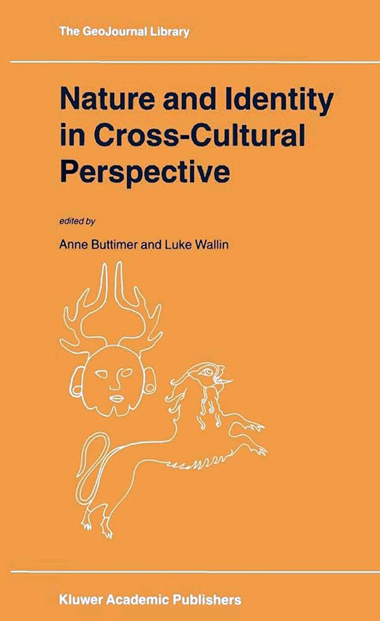





From International Research in Geographical and Environmental Education
"Nature and Identity in Cross-Cultural Perspective will be of great interest to students of environmental history and those who seek to recognise the variety of ways in which human cultures have imagined their relationship with nature."

by John Morgan, Institute of Education, University of London
Over the past three decades the broad field of humanistic geography has produced a wide-ranging and thought-provoking literature that is concerned with the meanings that people in a variety of places attach to the natural world. Gaining access to these meanings requires close attention to a variety of sources, ranging from material artefacts, paintings, novels and the testimonies of people themselves. Whilst humanistic geography has always paid close attention to the specificity of human geographical experience and the long history of human habitation of the earth, in recent years, humanistic geography has been influenced by the so-called 'textual turn' in the arts and humanities. The achievement of Nature and Identity in Cross-Cultural Perspective is to provide a fascinating mixture of older and newer approaches to humanistic geography.
The book comprises a collection of 20 essays, organized into three sections. In the first section the focus is on the relationship between culture and nature as reflected in the geographical traditions of a variety of places. Thus, starting from Clarence Glacken's magisterial essay on the history of Western attitudes to nature, various contributions discuss the geographical traditions in East Asia, Japan, India, and the Middle East. These essays thus range over the world's major religions and serve to highlight the diversity of geographical thought about culture and nature. These broad accounts of the relationship between culture and nature are then examined more closely in the second section of the book, whose focus is the contest between 'Official' and 'Folk' visions of nature.
These essays are concerned with highlighting the tensions that exist about the meanings and use of nature within specific places. Thus, there are chapters on how policymakers' assumptions about the use of water and forestry resources in Spain floundered in the face of local beliefs, how the Mayan population of Guatemala opposed and contested the dominant conception of landscape imposed by Spanish colonists, and the different geographical imaginations of the Arctic held by the indigenous population and Western 'outsiders.' These chapters focus on what might be called 'cultural politics,' that is, the struggle to define meaning about the environment on the part of dominant groups and the attempts to resist or contest those meanings by subordinate groups.
The essays in this section provide a useful bridge to the essays in the third section of the book that make use of insights from the 'new cultural geography' to consider the role of literature in constructing 'stories' or narratives about nature and culture. William Cronon's contribution focuses on how the history of the Great Plains has been represented in a wide range of texts. He illustrates how such accounts cannot be simply judged 'true' or 'false,' but seen as situated productions that reflect the times and visions of their storytellers. Cronon's essay is concerned with the implications of postmodernism for how we construct stories about places. It quietly raises important political questions about the contested nature of our geographical imaginations, and these questions are taken up by other contributors. Thus Charles Withers discusses how the Scottish Highlands have been constructed as a myth, 'an assemblage of ideologically-laden signs and images.' He outlines three ways in which the Highlands have been represented, first as an anthropological curiosity, populated by a 'savage' people closer to nature than people in other parts of the Kingdom, secondly, as a landscape fit for royalty, and thirdly, as a landscape subject to the competing moral claims of economists, ecologists and populists. Withers's account points to the fact that questions of representation of landscape cannot be divorced from questions of political power, since dominant representations of the Highlands invariably emanate from England.
Nature and Identity in Cross-Cultural Perspective will be of great interest to students of environmental history and those who seek to recognise the variety of ways in which human cultures have imagined their relationship with nature. For the general reader, the book contains a wealth of detail of specific examples and case studies. Part of the appeal of the collection is its cross-cultural focus that allows the reader to see how different cultures attach meanings to nature. There are useful chapters that summarise the contribution of geographers across a range of cultures that add to our understanding of the concerns of the discipline. The cross-cultural focus of the book makes it relevant to a broad audience and the editors have done a fine job in making a potentially disparate set of essays hang together.
Readers of IRGEE (International Research in Geographical and Environmental Education) will find much to interest them in this book, though it is perhaps the potential for undertaking postgraduate research that will be most useful. In particular, the chapters in the third section of the book offer some good examples of the types of discursive reading associated with the 'new cultural geography.' As an example, Cronon's aforementioned essay on the Great Plains would be an excellent essay for anybody seeking to understand some of the issues associated with postmodernism. For this reviewer, two possible areas for further research arise from a reading of this collection of essays. First, from the point of view of geography and environmental educators, it would be interesting to track how the broad understandings of nature and culture discussed in these essays are reflected (if at all) in national systems of education, for instance, as seen in national curriculum specifications and textbooks. Second, it would be interesting to investigate to what extent these distinctive cultural understandings of nature are responding to the forces of globalisation we hear so much about these days.
Note: This book has been acquired by university libraries throughout the world, and is available through inter-library loan.
⟶ Return to Longing for Wilderness page.